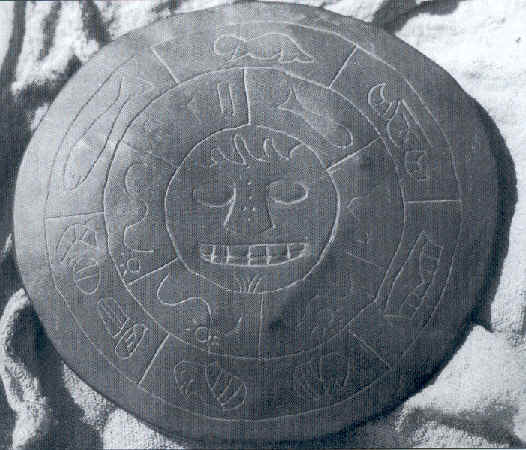
Found: The Indians' Astronomical "Key"
by John H. Bailey III
A resident of Melbourne, Florida, the author has been closely following events surrounding the discovery of a southern Illinois burial site which has so far yielded more than 7,000 stones inscribed with images suggesting ancient Old World influences. Found in 1982, the whereabouts of Burrows Cave is still unknown to all, save its discoverer, Russell Burrows. Even so, an abundance of internal evidence depicted on the artifacts, as described by John Bailey, underscore their archaeological authenticity. He is currently writing a new book on the subject, which will cover the inscribed stone discussed below.
There are many Burrows' cave stones, but few like the specimen presented here. Our photograph presents an astronomical key, used by ancient Indians and found in Illinois' Hellenic/Egyptian tomb. The artifact's center space is occupied by facial representation of the sun, similar to Maya calendars in Middle America. Someone holding it in the flat of his hands, with the stone face looking away towards the horizon, would be positioning it correctly to observe the sunrise. Notice four images of the sun, as it rises in different positions over tow hills, on the inside ring. Each point of sunrise marked sequential periods of the solar year, part of the same time keeping device used by ancient American Indians and recorded by the Greek/Egyptian colonists in southern Illinois.
Perhaps a large fish, or whale and what appears to be a seal, may be seen on the outer ring. These animals might refer to a mating season. In ancient times, seasonal changes, as well as the breeding cycles on animals, were closely observed. Several images on the outer ring depict celestial paths, where stars and the course of the moon were observed and recorded. A "Pac-man" like figure may be sighting paths of Venus during the summer and winter months (fig 1). The appearance of the planet Venus was one of the constants ancient American astronomers used to predict the rhythms of time. The circle bisected by two lines represents a heavenly body like the sun, moon or Venus with a path running through it, perhaps by a comet or another celestial body intersecting its path across the heavens.
Some of their paths clearly were observed by the ancients, who lined them up over mounds or hills of earth throughout the landscape. Path-like designs are common in the Mayas' picture-glyph system. One example resembles a domed hat, but upon closer examination, it portrays two small hills with celestial paths radiating upward into the sky (fig 2). The stylized figure in the center of these two little hills has his arms raised, ritually, it would appear. There seems to be either a full hill in front of this figure or a kind of primitive perspective. If the latter, then the little man-figure is standing on flat ground with a kind of bell-shaped area of land in front of him.
Evidently, the outer rings have something to do with what is going on in the inner rings. When the sun rises from particular points of the horizon, the ancient astronomer is directed to follow the line from that central part of the wheel to a picture on the outer wheel (fig 3). It reminded the astronomer to take either a lunar or celestial reading from one of the nearby hills or landmarks, thus checking his solar and celestial markers. Two hills with two celestial paths above them are shown here (fig 4).
During pre-Columbian times, extensive exploration of the Americas resulted in documenting Indian culture by way of inscribed objects, such as this astronomical key from Burrows Cave. This conclusion was supported by an artifact in a private collection I was allowed to examine recently. It featured three ancient Libyan inscriptions accompanying portraits of various Indians. Skeptics may argue that the stone is Native American in origin, and archaeologically worthless, because it is no longer in the context of its discovery. But when we consider this inscribed stone as one among many comprising an ancient library, its origins and value as an artifact of pre-Columbian visitors from overseas become clear.

Photograph and sketches by John Bailey

Note from Paul Schaffranke: After reading this hideous article, it occurred to me that John Bailey's original report must have been tainted and twisted by either Wayne May, Frank Joseph or both working together. No former under-study of mine could have ever written so horrible a work as this one.